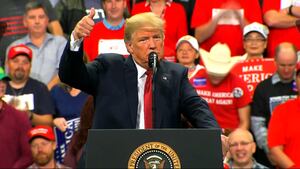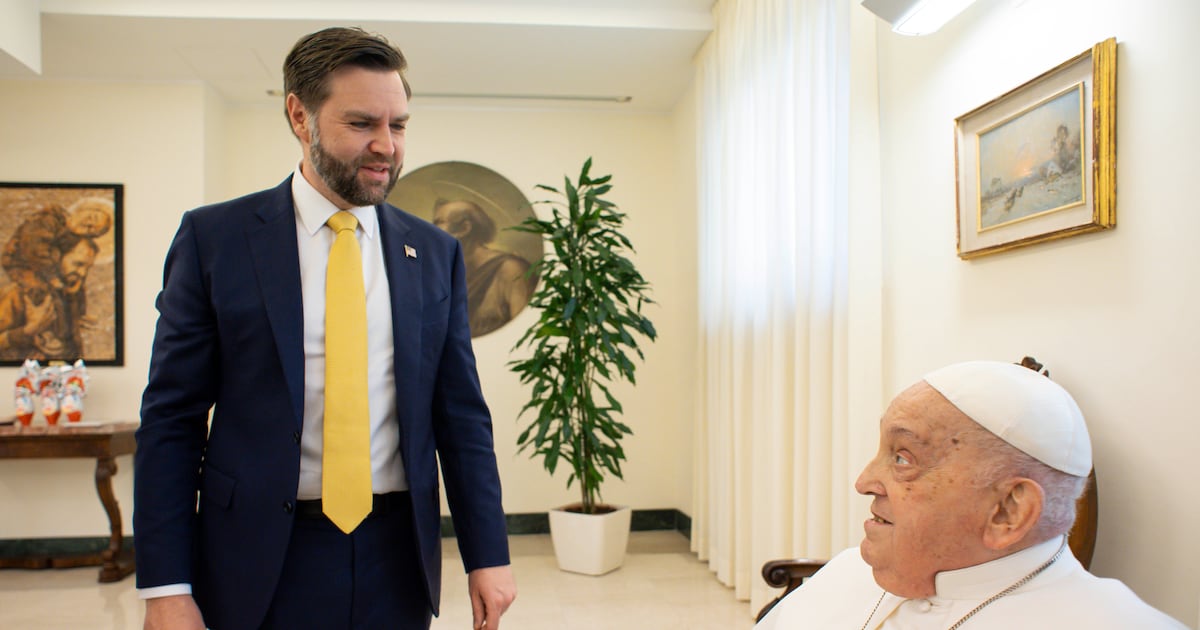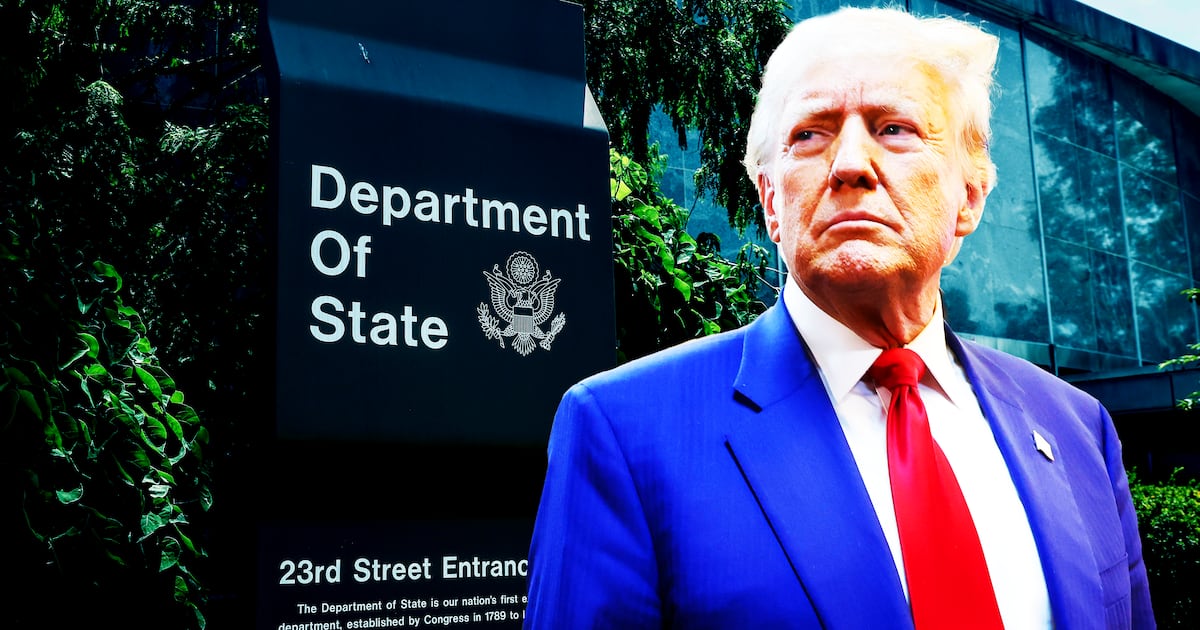PLYMOUTH, Minnesota—It’s a crisp Sunday afternoon in late September and Rep. Erik Paulsen is out running for re-election.
Literally.
The five-term congressman is jogging, practically sprinting, between the rows of houses in a residential neighborhood in the Minneapolis suburbs, greeting voters with small talk and sliding campaign flyers between screen doors. At one point, he leaps over a wooden fence and bounds up a hilly yard to shave some time off the route. Paulsen tends to travel at a fast clip—a day before, he zigzagged through the street at a breakneck pace in an apparent effort tell every single resident of the town of Plymouth that it was a “great day for a parade”—and this particular speed round of voter outreach is being squeezed in between the end of a Minnesota Vikings game and an early evening conference call.
But there’s an underlying urgency fueling him, too. The Minnesota representative is one of this year’s most vulnerable GOP incumbents. And key to keeping his seat in the increasingly Democratic district will be persuading the district’s voters, including the 51 percent who cast a ballot for Hillary Clinton in 2016, that he’s not another Trump Republican.
“I think a lot of the pundits expect that if the mood of the country is one way, they put everyone in one box,” Paulsen told The Daily Beast in an interview before the canvassing got underway. “But Minnesotans are ticket-splitters and they will always look at the person rather than the party.”
How Minnesota’s ticket-splitters vote is a central question that will affect more than the outcome of Paulsen’s re-election. With four competitive House seats in play and races for governorship and both U.S. Senate seats on the ballot, the longtime Democratic stronghold in the upper midwest has emerged as a bellwether battleground in the 2018 midterms. On top of that, all four districts include the the white, middle class, suburban voter demographics Republicans must win across the country to keep control of the House.
“Minnesota’s clearly the center of the political map this year,” Jeb Fain, communications director for the pro-Democrat House Majority PAC, said.
Minnesota’s match-ups have given both parties pick-up opportunities—and reason to play defense. Paulsen and Rep. Jason Lewis, a first-term Republican, are facing a closely divided electorate and a surge of Democratic energy in their re-election bids in suburban swing districts. Farther out state, national Democrats are defending open seats in rural districts that, despite being longtime strongholds for the state’s Democratic-Farmer-Labor Party, went big for Trump in 2016. Both parties acknowledge that the path to controlling the House could very well run through the state.
“If we win both of our incumbent races and either of the challenger races, we will be in the majority,” National Republican Congressional Committee chairman Rep. Steve Stivers told reporters at a breakfast hosted by the Christian Science Monitor last month. “If we win one of the incumbent races and one of the challenger races we are probably in the majority. If we lose both the incumbent races and none of the challenger races we are probably in the minority.”
Given the high stakes, both sides are spending millions on the airwaves, making Minnesota one of the top states for ads and spending so far this cycle. Health care, the economy and voter frustration toward Washington loom large. Trump has already made two trips to the state, promising in a recent Rochester rally that Republicans will deliver a “ very big surprise” in November. Minnesota Republican Party Chairwoman Jennifer Carnahan, who praised the visit as a “dream come true,” told reporters that his trip “shows that the White House and the president understand how critical Minnesota is towards our national landscape and Republicans maintaining the majority.” Democrats, meanwhile, point to big turnout in the primary and anger over #MeToo and the sexual assault allegations faced by Supreme Court Justice Brett Kavanaugh as signs they are galvanized, especially in the two suburban districts. In the last two weeks alone, the regional chapter for Planned Parenthood’s political arm saw its volunteer ranks quadruple.
“I think people are more motivated than ever,” BreAnna Bemboom, a field organizer for Planned Parenthood Minnesota, North Dakota, South Dakota Action Fund, said. “People are angry and they’re frustrated and they’re ready to take action. They’re going to show up on the polls.”
So far, a significant amount of spending and attention has been focused on Paulsen’s race. The incumbent Republican, first elected in 2008, is fighting to hold a seat that Hillary Clinton won by 9 points in 2016. This year, he’s facing Democrat Dean Phillips, a wealthy liquor heir and coffee shop owner who’s made headlines for his quirky campaign tactics and pledge to reject corporate PAC money. Polling putting Phillips in the lead and Trump’s sagging approval ratings in the state have led some handicappers to shift the race to “Lean Democrat” in recent weeks.
“Some of these voters are now saying I really don’t like Trump and I’ve got to vote [in this race] against Trump,” David Schultz, a political science professor at St. Paul’s Hamline University who predicts the seat will flip, said. “It’s a combination of anti-Trump and Democrats being more mobilized, evidence suggests they are.”
Paulsen acknowledges that the “level of energy with the opposition is higher,” this year but insists that his track record of making it through “really competitive and tough races” and voters’ tendency to split the ticket gives him an edge. He won by 14 points—an even bigger margin than Clinton—in 2016.
“It’s always a competitive race,” he said. “That’s just the nature of the district and the nature of Minnesotans.”
To those voters, especially the ones who cast votes for Clinton and the congressman on the same ballot last cycle, Paulsen needs to maintain distance from the president. And sure enough, Paulsen, who says he did not vote for Trump, is quick to point out that he split from the administrations on key issues. He made fighting the administration on protecting Minnesota’s Boundary Waters a focus of his first ad.
“I’m certainly not afraid of standing up to my own party or the president. I’m number three for bipartisan bills [authored in Congress],” he said. “The Boundary Waters, immigration, trade are all issues where I have different views from the president and express those pretty directly.”
Even when the president came to the state, both men stayed away from each the other.
Paulsen skipped the president’s campaign rally in Rochester—his campaign manager told The Daily Beast he had to take his elderly father to a doctor’s appointment—and Trump didn’t name-drop Paulsen as he praised other GOP contenders in the state.
And on the campaign trail and airwaves, instead of talking about the White House’s record, Paulsen and allies have sought to make the election a referendum on Phillips’ character, spending millions to frame the wealthy businessman as an untrustworthy hypocrite over his initial decision not to offer healthcare to part-time employees at his coffee shop (full-time workers now receive benefits) and a series of late business tax filings.
Phillips, whose “Everyone’s Invited”-themed campaign can border on parody (during one recent parade, his “Government Repair Truck” mobile-office-slash-coffee shop, blared “America The Beautiful” as volunteers blew bubbles into the crowd), is also walking a fine line in appealing to the district’s crucial swing voters. While he supports progressive priorities like expanding Medicaid and opposing corporate campaign cash (and welcomed an endorsement from Obama), he’s stopped short of others, such as full repeal of the president's tax bill or a vow to vote for impeachment. Instead, he’s positioning himself as an accessible centrist, hammering Paulsen’s party-line voting record, pledging to host regular town halls and touting events and web videos featuring Republican supporters.
“It’s a very purple district and I think at the root of the lowest common denominator, Republicans and Democrats agree that our country needs a check on the executive branch, no matter who inhabits the White House, to fulfill our system of governance. And that constitutional duty is not being performed by Erik Paulsen and way too many members of Congress,” he told The Daily Beast after an early voting press conference last month.
That message has resonated with Ruthie McCoy. The 67-year-old retiree usually skipped voting in midterms in the past, figuring the presidential races were what really mattered. This year, that changed. On a frigid early fall morning, she headed out bright and early to cast a ballot on the first day of early voting in Minnesota. The reason? Phillips’ ebullient and positive bid in the face of so many negative ads.
“I was so compelled by what’s going on, I decided to participate and try to help out as much as I can,” McCoy, who identifies as an independent and has voted for both parties in the past, said outside the Plymouth City Hall. “I can count on him to work for the people in this district.”
True to form, Phillips was there, along with the kitschy red, white and blue van. He bounced through the entryway, doling out his signature high fives to McCoy and other supporters.
“We’ve got one vote! Now we just need 179,243 more!” Phillips gushed as they posed for a photo. “This is awesome, seriously! You made my day!”
Indeed, even with the rancor, the fight has taken on a distinctly Minnesota flavor. Paulsen’s first ad featured him standing in front of one of the state’s 10,000-plus lakes (though not the Boundary Waters network of waterways he was voicing support for in the spot). Phillips, meanwhile, has been staging meet-and-greets at iconic Minnesota locales, including ice-fishing shacks, the deep-fried food mecca that is the state fair and even aboard his family’s pontoon boat. His most popular web ad featuring a befuddled Bigfoot searching for Paulsen. The ad aired once on TV, during a Vikings game, naturally. “When they go low we’ll go high, and we’ll go funny, too,” Phillips said.
More recently, the campaigns tangled in a classically “Minnesota nice” (read: passive aggressive) exchange: Paulsen’s campaign wrote the opponent to ask if they could to film an ad inside Phillips’ Minneapolis coffee shop, which has been both subject of attacks from the Republicans and a hallmark of the Democrat’s campaign. Phillips, politely, said of course, free of charge, and even offered to be on hand for the filming. Such an ad has yet to hit the air.
Outside of the Third District, the races are shaping up along more traditional narratives—and national trendlines. Angie Craig, the former health care executive who lost to Lewis by about 6,000 votes in 2016, is doubling down on health care, reproductive rights and security, all issues that could appeal to crucial women voters in the suburban Second Congressional District. Former Planned Parenthood President Cecile Richards and Democratic Sen. Amy Klobuchar are among the big names who have come to stump for the Democrat in recent weeks.
“She’s going to benefit from #MeToo and she’s going to benefit from Brett Kavanaugh,” Schultz said. “The most important swing vote in the U.S. is suburban women and she’s running as a female candidate trying to appeal to female voters.”
Lewis, whose incendiary comments as a conservative radio host have once again surfaced in the campaign, appears to be doubling down in his support of Trump—and belief that the Kavanaugh saga has energized the GOP base as well. He appeared on stage with the president in Rochester and, after Kavanaugh’s nomination, he released a strongly worded statement blasting the process as a “sad circus” and warning that “the societal glue that holds us all together will dissolve and in the process no individual will be safe from deliberate smears solely designed to attain political power” should Democrats win.
In Minnesota’s 8th, a sprawling district that covers Minnesota’s Iron Range, a traditionally Democratic stronghold, and conservative suburbs to the North of the Twin Cities, Democrat Pete Radinovich and Republican Pete Stauber are sparring everything from trade policy to traffic tickets. Voters in the district, represented by retiring Democratic Rep. Rick Nolan, swung for Trump by double-digit margins after going for Obama in both 2008 and 2012. Most polling shows the race neck-and-neck. And in the 1st District, signs are emerging that Republicans see the seat that was long held by Democratic Rep. Tim Walz, who is running for governor, as within reach, despite Republican nominee Jim Hagedorn’s history of offensive and sexist diatribes. Days after Trump’s visit, the Congressional Leadership Fund announced its first TV ad in the district, tying Democrat Dan Feehan, an Army veteran and Obama administration alum, to Nancy Pelosi.
The results of Minnesota’s races, especially any perceived Trump boost or backlash, could have consequences beyond which party controls Congress for the next two years. Political observers are closely watching the contests for signs of whether the state’s ten electoral votes will be in play in 2020. Voters haven’t picked a Republican for president since Richard Nixon’s 1972 campaign. But Trump, who lost the state by less than 2 points in 2018, has vowed to flip it next cycle. A strong performance by Republicans could help cements its reputation as a potential swing state in elections to come.
“In many ways we’re a state that’s really bordering right on the edge,” Schultz, who recently penned a book on swing states, said. “Is this a state that is ready to flip Republican and join the midwest? Or is it an anomaly in the midwest? What’s happening in 2018 might tell us something.”
Jackie Kucinich contributed to this report.







